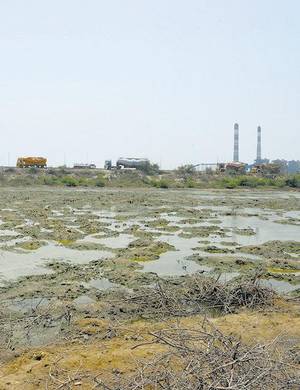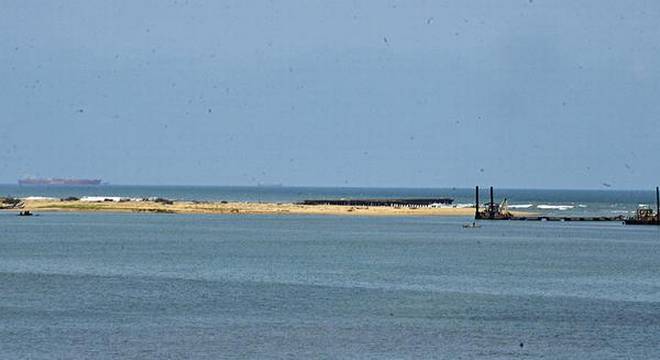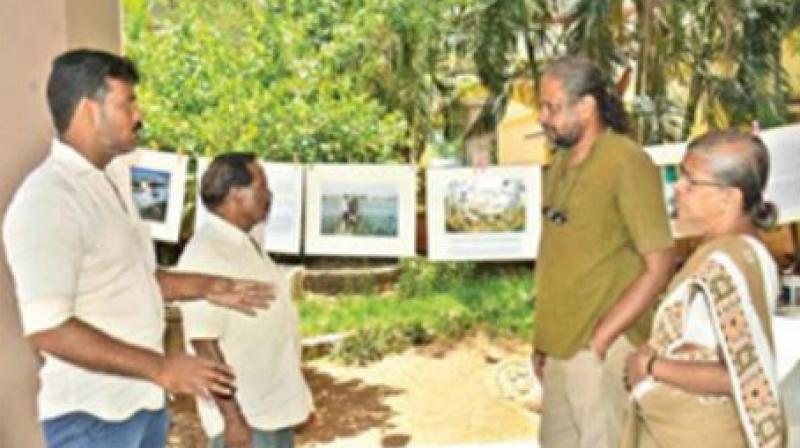After government and regulatory agencies refused to stop TANGEDCO from destroying mangroves and encroaching into the Kosasthalai River, more than 200 men and women from Ennore’s fishing villages arrived in boats to the work site to protect the precious Konamudukku mangrove patch from being cleared. The coal conveyor corridor for TANGEDCO’s Ennore SEZ project has already encroached into more than 15 acres of wetlands, including 1.1 acre of river and mangroves. On 13 July, the Electricity Minister said TANGEDCO’s activities were perfectly legal. But the company’s activities do not have a valid Consent to Establish from TNPCB. Moreover, the electricity company has made false declarations to the Union Ministry of Environment, Forests and Climate Change to get approval for its coal conveyor corridor. After using an alignment that avoids waterbodies to get an approval, TANGEDCO has illegally altered the alignment without informing the Union environment ministry. The current alignment is unapproved and runs mostly on waterbodies and mangroves.

If work continues at the current pace, the Konamudukku mangroves – identified as a No Development Zone in the approved 2018 Coastal Zone Management Plan (CZMP) – will be buried under 2 metres of sand within days. Local villagers complained that already one fishing ground locally known as padu — the Pazhaiyakal Pin Padu – has been buried by the ongoing encroachment.
Konamudukku is one of the most biologically productive patches remaining in the Ennore Pulicat wetlands. Five species of commercially valuable prawns – Vellra (white prawns), Mottra (Horned prawn), Kadamb Era (tiger prawn), Valchera (mud prawn) and Semakku Era (red prawns) – breed in the Konamudukku mangrove forests, making the waters around these mangroves among the choicest of fishing grounds. Besides fishermen who use boats, stake nets and hand cast nets, more than 2500 women from SC/ST communities earn a livelihood by hand-picking prawn and crab from mangroves such as this.
Fishers are disappointed with the government for refusing to stop TANGEDCO’s ongoing violation to save the environment and their livelihoods. “We know agencies like TNPCB will not dare regulate big and powerful violators. That is why we brought the matter to the notice of the district administration, and the environment and electricity ministers. Now, we are appealing to the Chief Minister because none of these people appear to care for our lives. We have already lost a lot to coal ash pollution by TANGEDCO and encroachments by roads, pipelines and infrastructure for power plants, coal yards and ports. Now, one of the last remaining sources of livelihood for us and numerous others including women fishers is being targeted. If Konamudukku mangroves and the deep waters around it are destroyed, we will be finished. It is telling about the state of affairs when all agencies of government are conspiring to commit an offence, and ordinary people are forced to intervene to enforce the law.” the fishers said.
On 12 July, a team of three eminent citizens – including Prof. S. Janakarajan, musician and activist T.M. Krishna and Poovulagin Nanbargal’s G. Sundarrajan – visited two sites of ongoing encroachment and violations by TANGEDCO. In a report submitted by them to the Chief Minister, the three said that “TANGEDCO is misleading the government on its illegalities.” They warned that “The government needs to note that the already substantial liability, in terms of penalties, compensation for fisher livelihoods and harm to health, remediation costs and criminal prosecution of TANGEDCO officials will be magnified if corrective action is not taken immediately.”
Villagers and city-based activist groups such as Save Ennore Creek campaign have asked the government to ensure that the ongoing work is stopped, the damage to ecology reversed and fisherfolk compensated for the damage to their livelihoods.
For more information, contact: K. Saravanan: 9176331717. Nityanand Jayaraman: 9444082401 (Save Ennore Creek Campaign)
R.L. Srinivasan: 9962733450. Fisherman, Ennore
Read More »



